Abstract
Earthen architecture largely supports the concept of sustainable building. In the seismically active area of eastern Croatia, there is a large number of rammed earth houses, many of which are over 100 years old. All these houses were built using empirical knowledge, i.e., without applying national design standards. In order to support the preservation of ethnic villages and traditional rammed earth houses, a field survey was conducted. Parts of the walls of traditional rammed earth houses were collected, and the material was thoroughly analyzed. Samples of rammed earth were reproduced, and tests were carried out with the aim of determining the shear strength to subsequently determine the seismic behavior of Croatian traditional earthen architecture. This paper presents the results of shear strength tests on samples with different particle size distributions, lime content, the straw of different cereals but also hemp fibers. An increase in shear strength was observed with the addition of natural fibers to the samples.
1. Introduction
Earth architecture provides a home to about half of the world’s population [1], with some of the buildings being found in seismically active areas [2,3]. The soil used for construction of such buildings varies depending on the locations of construction, but there are still recommendations related to suitable particle size distribution [4,5,6,7] and soil plasticity [4,5,8,9]. Rammed earth houses can be unstabilized, where the clay particles act as a binder, but also stabilized, mostly with cement and lime [10,11,12,13]. Unstabilized rammed earth houses are conducive to sustainability and reduced energy consumption [14,15]. However, such buildings have mechanical properties, which significantly depend on the soil used but also show reduced resistance to external loads if they are not properly constructed [12]. The use of industrially produced binders can increase their strength, durability and resistance, but the impact on the environment also increases [10,12]. Walker et al. [5] state that the emission of CO2 during the production of lime is lower than that of cement, but that when choosing lime rather than cement, its impact on the environment should still be taken into account. In the case of soils with higher clay content and organic matter, lime is more suitable than cement [5]. In addition, a mixture of soil and lime can be returned to nature when demolishing an abandoned rammed earth house, since, in agriculture, lime is used to improve the soil quality for the cultivation of certain agricultural crops. In a review by Ávila et al. [13], better uniaxial compressive strength (UCS) was reported after the addition of cement compared to the addition of lime. In the same paper, it was noted that the proportion of lime for the observed improvements was usually in the range of 3–5%, while the proportion of cement was much higher (usually around 10%).
Another way to improve the properties of rammed earth is by adding natural or artificial fibers. Soil, like concrete, has good compressive strength, while its tensile strength is not as good. Just as reinforcement is added to concrete to take tensile forces, the tensile strength of soil can also be improved by using certain additives. This can be in the form of industrially produced materials (e.g., fiberglass) or natural materials (e.g., brushwood, straw). Figure 1 shows brushwood embedded between the layers (the wall of a house in Čeminac) and pieces of cereal straw (the wall of a house in Aljmaš).
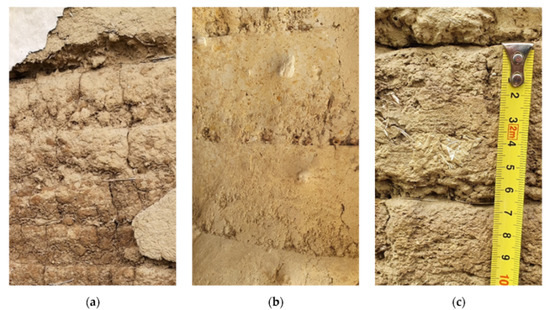
Figure 1.
Photographs of traditional rammed earth walls from the area of eastern Croatia in the locations of: (a) Čeminac (outer wall); (b) Aljmaš (inner wall); (c) Aljmaš (outer wall).
Laborel-Préneron et al. [16] group natural fibers into: cereal straw, wood aggregates, bast fibers, palm tree fibers, waste and residues, leaf fibers, aquatic plant fibers and chips, and sheep wool. Ávila et al. [13] list fiberglass, polypropylene fibers and waste tire fibers as some artificial fibers that could possibly be used for incorporation into rammed earth soil mixtures. The use of fibers reduces cracks that can occur due to the drying and shrinkage of rammed earth [17,18]. Koutous and Hilali [19] outline the advantages of using fibers (where barley straw and date palm fibers were examined) in the form of increased compressive and tensile strength and increased ductility. Based on the increase in ductility by fiber reinforcement, Koutous and Hilali [19] suggest that fibers can be used in earthquake-resistant constructions. Walker et al. [5] argue that adding cereal straw or other natural fibers can potentially affect thermal conductivity (due to lower density). In addition, rammed earth with the addition of natural fibers can have a lower impact on the environment compared to rammed earth stabilized with industrially produced binders [13,19]. Although improving the properties of rammed earth is affected by the proportion of fibers in rammed earth houses, the optimal proportion of fibers has not been sufficiently investigated [16]. Walker et al. [5] only state that the mass fraction of fibers for rammed earth houses is likely less than 1 to 2%. Prabakar and Sridhar [20] report a reduction in shear stresses with sisal fiber proportions greater than 0.75%. In the research conducted by Galán-Marín et al. [18], a smaller proportion of sheep wool fibers (0.25%) proved to be more suitable.
Rammed earth shear strength is an important parameter to consider when designing in seismically active areas. Geotechnical tests (e.g., the direct shear test) and test techniques used in masonry structures (e.g., the diagonal compression test) are usually carried out. According to Bui et al. [10], shear strength should be defined as a function of cohesion, friction angle and normal stress value (Mohr–Coulomb theory), and they state that shear strength can also be assumed as 10% UCS. The values of cohesion and the internal friction angle of soil samples for rammed earth houses can be determined using direct shear tests [21,22,23,24] but also with triaxial tests [25]. Tests are usually conducted on samples of larger dimensions. For example, in Kosarimovahhed and Toufigh [24], samples with dimensions of 150 × 150 × 180 mm were observed, and in El-Nabouch et al. [22], samples had dimensions of 100 × 100 × 35 mm and 500 × 500 × 450 mm. However, tests on smaller samples have also been reported [21]. Usually, tests are carried out on samples of a certain age, since rammed earth walls are built inside the formwork and remain inside the formwork for a certain period. In the literature, tests are reported on samples aged 7 days [21], 30 days [23], 60 days [22] and 90 days [24]. When observing the shear strength values, it is necessary to keep in mind the different values at the layer contacts compared to the values within the layer itself. El-Nabouch et al. [23] state values of the internal friction angle at the contact in the amount of 90% in relation to the internal friction angle of the layer itself. The recorded value of cohesion in the observed case was even lower, i.e., 80% [23]. In Perić et al. [26], a literature review is presented related to the testing methods of the mechanical properties of unstabilized rammed earth, one of which was applied in this study.
In the seismically active area of eastern Croatia (Figure 2, Table 1), there are examples of rammed earth houses that are more than 100 years old. Unfortunately, there are no standards or recommendations in Croatia related to the construction of rammed earth houses nor to their renovation. Moreover, to the best knowledge of the authors, no studies have been carried out on the load-bearing capacity and resistance of such structures for the observed area.
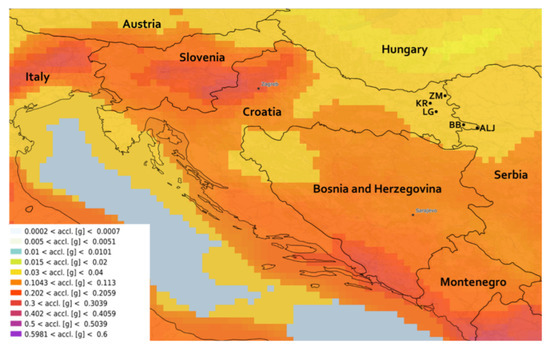
Figure 2.
The earthquake hazard map of Croatia and bordering countries [27] with markings of the places from which the rammed earth samples observed in this work were taken: Aljmaš (ALJ), Bijelo Brdo (BB), Karanac (KR), Lug (LG) and Zmajevac (ZM).

Table 1.
Geographical coordinates of the study area.
The aim of this research is to determine, based on the results of the shear strength test: (i) the suitable grading curve of mixtures that were formed on the basis of the grading curves of samples from existing traditional rammed earth houses from the area of eastern Croatia; (ii) the influence of lime; (iii) the influence of cereal straw and hemp fibers. A further aim is to determine the change in shear strength for samples of different age. Chapter 2 provides an overview and description of the observed mixtures on which direct shear tests were performed, as well as a description of the test procedure. Chapter 3 presents the results of the performed tests. Chapter 4 provides a discussion of the results, and finally, in Chapter 5, the conclusions are given.
2. Materials and Methodology
2.1. Materials
For the purpose of testing, samples were formed with locally available soil (mixture M1) and by mixing locally available soil with a certain proportion of sand and gravel (mixtures M2–M11). The composition of the mixtures was chosen in accordance with the grading curves of the soil samples collected from traditional rammed earth houses from eastern Croatia (Figure 3; [28]) but also in accordance with the grading curves published in the literature related to research conducted in Portugal [29] and France [30]. Samples from eastern Croatia rammed earth houses were collected following the methodology described in Ref. [1]. Figure 4 shows the grading curves of the observed mixtures, which were determined by a combination of sieving and sedimentation in accordance with HRN EN ISO 17892-4 [31]. Table 2 introduces the grading parameters of traditional and reproduced mixtures observed in this paper. The granulometric curves of traditional earthen materials from the Republic of Croatia used for rammed earth walls are introduced for the first time in this paper. With this, the global database of granulometric curves for earth materials used to build rammed earth houses is expanded.

Figure 3.
Grading curve of soil samples from traditional rammed earth houses from the area of eastern Croatia [28].
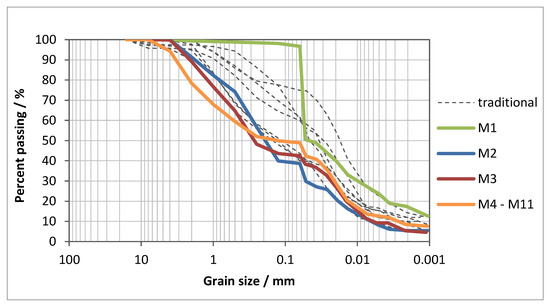
Figure 4.
Grading curve of mixtures M1–M11.

Table 2.
Grading parameters of traditional and reproduced mixtures.
Since the largest grain size in the specimen for the direct shear test (according to Ref. [32]) should not be larger than 1/5 of the specimen height, the particle size distributions of the mixtures were formed with the largest grain of 4 mm. Nevertheless, deviations in the grading curves of mixtures with such corrections in relation to the grading curves of soil samples from rammed earth houses from the area of eastern Croatia are not significant, since, in the mentioned samples, the proportion of particles larger than 4 mm for most of the observed samples was less than 5% (Figure 3).
In mixture M5, 4% of lime was added (by mass), while in mixture M6, 8% of lime was added (by mass). The proportion of lime in the mentioned mixtures was chosen based on the recommendations given by Ciancio et al. [33], where the optimal proportion of lime for application in stabilized rammed earth was studied. In the aforementioned paper, an optimal proportion of 4% lime was recorded, while in the current research, twice the proportion (8%) was added in order to determine the influence on the shear strength. Lime was added to a mixture of locally available soil and gravel with the same particle size distribution as in mixture M4.
Cereal straw was added to four samples, specifically, barley (mixture M7), oat (mixture M8), wheat (mixture M9) and rye (mixture M10); in one sample, industrial hemp fibers (mixture M11) were added. Cereal straw and industrial hemp fibers (Figure 5) were cut into lengths of approximately 2 cm and added at a mass fraction of 0.25% to a mixture of locally available soil and gravel (of the same particle size distribution as M4), thus creating mixtures M7 to M11. According to the reviewed literature, specifically [13,16,19], the mass fractions of cereal straw and industrial hemp are usually less than 1%, and in most cases, they are equal to 0.75%. With this research, the aim was to investigate whether smaller fractions of fibers also contribute to the shear strength of the material. A mass fraction of 0.25 percent was selected, which is less or equal to one-third of the mass fraction employed in the literature we studied. As part of the continuation of research, it is planned to test another mass fraction of fibers (in addition to 0.25%) in order to determine the optimal fraction for rammed earth walls.

Figure 5.
Cereal straw and hemp fibers used for mixtures M7–M11.
Table 3 provides a detailed presentation of the basic data on mixtures M1–M11.

Table 3.
Composition of observed mixtures.
Since Atterberg’s limits also affect the suitability of the soil for the construction of rammed earth houses, they were tested according to HRN EN ISO 17892-12 [34]. The liquid limit of the previously prepared sample, where the largest grain was 0.425 mm, was tested with a fall cone test (80 g/30° cone). The plastic limit was tested by hand-rolling the part of the sample prepared for the liquid limit test. The liquid limit determined for basic cohesive soil is 37.4%, while the plastic limit is 21.1%, which is in accordance with the recommendations given in the literature [4,5,8,9]. The stated values are also close to the values of the liquid and plastic limits of samples collected from rammed earth houses in eastern Croatia [35].
Additionally, the particle density of locally available soil, sand and gravel was tested with the fluid pycnometer method according to HRN EN ISO 17892-3 [36]. Lime density was tested using petroleum instead of distilled water in pycnometers. The particle density of mixture M1 was 2.67 g/cm3; for M2, it was 2.7 g/cm3; and for M3, it was 2.71 g/cm3, while for the remaining mixtures, it was 2.65 g/cm3 (for mixtures M7–M11 without natural fibers).
2.2. Sample Installation and the Direct Shear Test Procedure
For the purposes of forming specimens, a cylindrical mold with a height of 300 mm and a diameter of 150 mm was used, inside which a smaller square mold for a specimen with dimensions of 100 × 100 × 20 mm was placed (Figure 6) on top of the already compacted soil layer. After placing the square mold, the mixture for the next layer was added and then compacted. After opening the cylindrical mold, the square mold was taken out together with the specimen. To the authors’ best knowledge, this is the first attempt to ascertain the shear strength of the lowest zone of the rammed earth layer (see Figure 1).
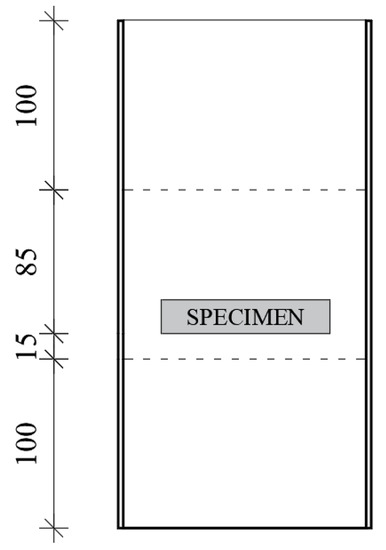
Figure 6.
Specimen position inside the cylindrical mold (in mm).
The sample installation was carried out in layers. For each layer, 3.5 kg of the mixture was prepared (before adding water to achieve the desired moisture content; the approximate height of the compacted layer was 10 cm).
The direct shear test was carried out on specimens with dimensions of 100 × 100 × 20 mm (Figure 7), and the tests were carried out on specimens immediately after installation (labeled 1 day) and on specimens 7 and 28 days old that were cured under controlled conditions in a chamber with 55% relative humidity and at a temperature of 25 °C.
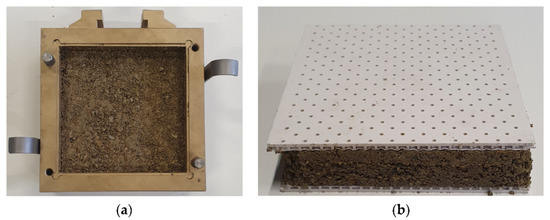
Figure 7.
M5 specimen (a) before and (b) after the test conducted using direct shear device.
The main objective was to ascertain the behavior of specimens that were cured for 28 days, which is the curing time recommended by the majority of the literature evaluated discussing rammed earth [26]. It was later discovered through field research that the moisture content in the walls of existing rammed earth houses can range from 6.5 to 8% at a height of approximately 0.50 m above the ground. The same research revealed that the moisture content in the walls of existing rammed earth houses is approximately 2% at a height of approximately 1.50 m above the ground. Consequently, it was decided to conduct additional tests on specimens cured for 1 and 7 days in an effort to identify a general pattern regarding the influence of relative humidity on the shear strength and cohesion.
Although the Proctor test is generally used to determine the soil optimum moisture content [5,37,38,39], the required moisture content of rammed earth materials can also be determined with a drop test [5,7,37,38]. In this research, the moisture contents determined by the drop test proved to be optimal for the compaction. The average moisture contents during installation were in the range of 13.0–20.3% (Table 4). However, as part of the study, a Proctor test (according to Ref. [40]) was also performed for samples M1–M4 in order to compare the results and determine the densities. For sample M1, the maximum dry density (MDD) of 1.69 g/cm3 at the optimum moisture content (OMC) of 16.7% was determined. For sample M2, the MDD was 1.99 g/cm3 at OMC 12.0%; for sample M3, the MDD was 1.98 g/cm3 at OMC 11.3%, while for sample M4, the MMD was determined to be 2.01 g/cm3 at OMC 10.5%. By comparison with the results shown in Table 4, it can be seen that the moisture content of the samples determined by the drop test is higher compared to the OMC determined by the Proctor test. However, Minke [38] recommends the use of higher than optimal moisture contents and states that it was shown that a moisture content that was 10% higher than optimal gave better results for compressed soil blocks. Standard NZS 4298 [41] states that the moisture content during compaction (for rammed earth constructions) can be 6% higher or 4% lower than the established OMC. The moisture contents obtained by the drop test are in accordance with the mentioned values and recommendations.

Table 4.
Moisture content of the mixtures.
The mixtures were prepared 24 h prior to compaction in order to achieve a uniform moisture content of the sample. This practice has been recorded in the construction of rammed earth walls around the world [38] but also in eastern Croatia, where the mixture for installation is prepared at least 12 to 24 h before installation [42]. A certain amount of water was also previously added to the cereal straw and hemp fibers (approximately 24 h before installation) in order to absorb a sufficient amount of water to reach a saturated, surface-dry state, and on the day of installation, they were mixed with the soil mixture. Lime was added to the mixtures (to which a certain amount of water had been added at least 24 h beforehand) immediately before sample compaction in order to prevent binding before sample installation.
A Proctor rammer type A (weight 2.5 kg, diameter 50 mm, drop height 305 mm) was used for compaction. Following installation with controlled compaction energy, a foil was placed on the first layer, and approximately 0.5 kg of the material of the second layer was added, after which a smaller mold with dimensions of 100 × 100 × 20 mm was placed. After adding the remaining material of the second layer, the second layer was compacted. The foil had the function of easier separation of the compacted layers and of protecting the sample in the smaller mold from possible damage when separating the excess soil. The position of the smaller mold, inside which the test specimen was located, was selected within the lower third of the specimen height. The reason for this is that during the inspection of traditional rammed earth houses in eastern Croatia, the parts with the most voids were observed in the lower third of the layers, which are potentially critical places in the walls. In accordance with the information collected from the field survey [28,35], the height of the layers for compaction in the mold was chosen, which was approximately 100 mm (in a compacted state). The height of the compacted layers of rammed earth in traditional houses from the area of eastern Croatia ranges from 50 to 150 m [28]. The specimen was pressed from the smaller mold (after the necessary measurements/weighing) into the shearbox mold for the specimens that were tested on the same day. Specimens aged 7 and 28 days were pressed out of the mold onto the pad, taken to the climate chamber and kept under controlled conditions. The average moisture contents of the samples during testing are given in Table 4.
Tests were performed in direct shear devices AUTOSHEAR (CONTROLS), where specimen shearing was performed along a predefined failure plane. The test was carried out in two phases: (i) consolidation and (ii) shearing. The vertical stresses (σn) to which the samples were subjected during consolidation and shearing were 25 kPa, 50 kPa and 100 kPa, which are common internal stresses in the walls of traditional rammed earth houses from the area of eastern Croatia. In the case of samples that were tested on the day of installation, a longer duration of consolidation was required (according to Ref. [32]), while in the case of samples that were tested after 7 and 28 days, a shorter duration of consolidation was conducted. The shear rate was 1 mm/min. The higher shear rate was chosen for comparison with other tests conducted as part of a larger study, and the stated rate was also recorded in other rammed earth studies [21,22].
3. Results and Discussion
The direct shear tests included samples of different particle size distributions, lime proportions, cereal straws and hemp fibers in order to determine the influence of individual parameters.
A comparison of peak shear stress values (τ) for samples M1 to M4 that had a different soil composition is shown in Figure 8, where an increase in shear stresses (an increase in the sample strength) can be seen with the age of the sample. This can be attributed to the fact that the samples dried over time, i.e., lost moisture content. It can be seen that the lowest peak shear stress values were recorded for sample M1, which has the largest proportion of fine particles. Samples with a smaller content of cohesive soil, M2 and M3, proved to be better, that is, they had the highest strength. The exception is sample M3 at a vertical stress of 25 kPa, where a lower shear stress value was recorded after 28 days, possibly due to a certain sample disturbance. At lower vertical stress levels, for 1-day samples M1–M4, the approximate values of peak shear stress were recorded. However, since the observed samples or mixtures would be inside the formwork after installation (in rammed earth walls), the strength values of the aged samples are of interest. In the RE-forMS project [43], within the framework of which this research was also carried out, research was additionally planned and is being carried out with a broader range of particle size distributions of rammed earth mixtures (e.g., a higher proportion of gravel) in order to be able to outline the recommended grading curves for the area of eastern Croatia.
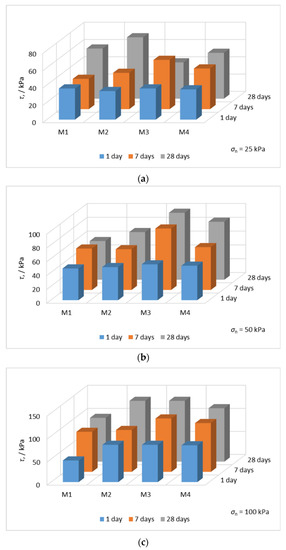
Figure 8.
Comparison of peak shear stress values of samples M1–M4 (influence of soil composition) for samples aged 1 day, 7 days and 28 days: (a) σn = 25 kPa; (b) σn = 50 kPa; (c) σn = 100 kPa.
For the purpose of improving strength, a certain proportion of lime was added to samples M5 and M6. Figure 9 shows a comparison of the peak shear stresses of samples that have the same particle size distributions, but where the lime content is varied. That is, sample M4 does not contain lime, sample M5 has 4% of lime (by mass), while sample M6 has 8% of lime (by mass). In these samples, too, approximately the same strength is visible as in the 1-day samples, that is, the stabilized samples had slightly higher peak shear stress values.
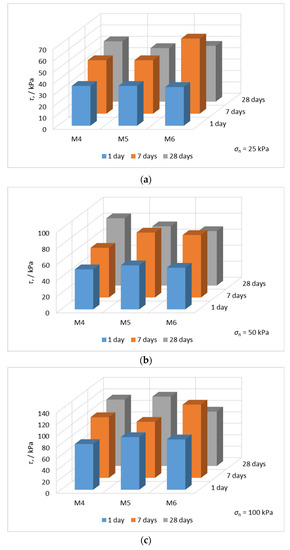
Figure 9.
Comparison of peak shear stress values of samples M4–M6 (influence of lime) for samples aged 1 day, 7 days and 28 days: (a) σn = 25 kPa; (b) σn = 50 kPa; (c) σn = 100 kPa.
Although in unstabilized samples (samples M1–M4), an increase in peak shear stresses was recorded with the sample age, in stabilized samples, a certain increase was recorded in the 7-day-old samples, while in the 28-day-old samples, there was mostly a decrease in the value of the peak shear stresses compared to the 7-day-old samples. Stabilized samples aged 7 days recorded higher strengths than unstabilized samples. As part of the RE-forMS project [43], it is planned to further investigate the influence of lime and the aforementioned phenomena. The samples with a lower lime content had a more balanced behavior, i.e., a weaker increase or smaller decrease in strength, compared to the samples with a higher lime content. If the results of samples aged 7 days are excluded from the analysis, the samples with 4% of lime appear to be better. It can be concluded that a lower lime content is more suitable for rammed earth mixtures. This is in line with the observations in Ref. [33], where it was noted that the addition of more than 4% lime to the mixture did not further contribute to an increase in UCS and stiffness. The optimum lime content for the observed mixture in the current research needs to be further investigated. It is also recommended to carry out tests to determine the optimum content prior to the construction of lime-stabilized rammed earth houses.
Figure 10 shows the test results of sample M4 (sample without additives) and samples M7–M11, which have the same particle size distributions but also additives of cereal straw or hemp fibers. The measurements show an increase in strength with the age of the sample, i.e., with a decrease in moisture content. The influence of straw and fibers on peak shear stress values for 1-day samples was not recorded or was negligible. A similar case applies to samples aged 7 days. The greatest influence on the sample shear strength is evident in the samples aged 28 days, where most had higher peak shear stresses compared to sample M4. The exception is sample M11 (sample with hemp fibers) at a vertical stress of 100 kPa, where a certain degree of sample disturbance occurred during the sample installation in the shearbox. Generally, the sample with the rye straw (M10) proved to be the best. A good contribution to strength was also recorded for the samples with barley (M7) and oat straw (M8).
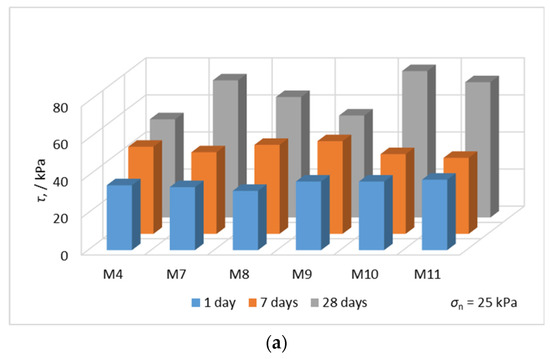

Figure 10.
Comparison of peak shear stress values of samples M4 and M7–M11 (influence of natural fibers) for samples aged 1 day, 7 days and 28 days: (a) σn = 25 kPa; (b) σn = 50 kPa; (c) σn = 100 kPa.
If the measurement for specimen M11 at a vertical stress level of 100 kPa for a sample aged 28 days is disregarded, the contribution of hemp fibers to sample shear strength could match that of rye and oat straw. This comparison proves the suitability of using the straw of the observed cereals and hemp fibers as micro-reinforcement in rammed earth mixtures.
The calculated values of the strength parameters for samples M1–M9 are shown in Figure 11, Figure 12 and Figure 13. There was no uniform trend of change in the cohesion values of the observed samples with sample ageing. However, all samples aged 28 days had higher values of cohesion compared to those of 1-day samples. The 1-day sample M1, which had a high content of fine particles, had the highest moisture content during installation and after testing. Since the shear rate was 1 mm/min, it is possible that the sample was closer to the undrained state, which is indicated by the approximate peak shear strength values but also by the very low value of the internal friction angle. In the case of the remaining samples, the moisture content was lower, as was the content of fine particles, and therefore, the reported state of the material was not so pronounced. It should be kept in mind that due to the high shear rate, the achieved values of cohesion and of the internal friction angle do not necessarily represent the values of cohesion and the internal friction angle that correspond to the results of a standard test at lower shear rates.
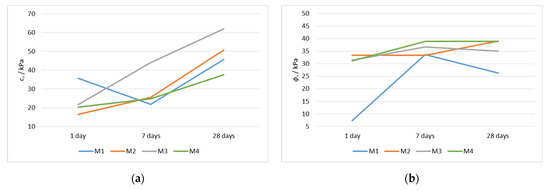
Figure 11.
Cohesion and internal friction angle values change with specimen age, samples M1–M4 (influence of soil composition): (a) cohesion; (b) internal friction angle.
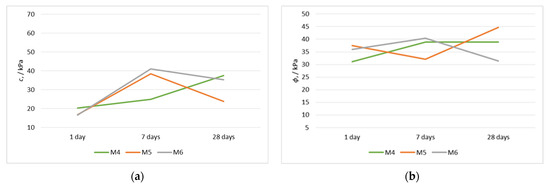
Figure 12.
Cohesion and internal friction angle values change with specimen age, samples M4–M6 (influence of lime): (a) cohesion; (b) internal friction angle.
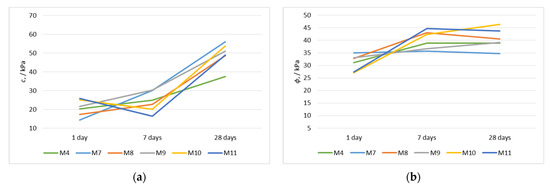
Figure 13.
Cohesion and internal friction angle values change with specimen age, samples M4 and M7–M11 (influence of natural fibers): (a) cohesion; (b) internal friction angle.
Samples stabilized with lime recorded a decrease in cohesion in the samples aged 28 days compared to the samples aged 7 days. Water loss may be the cause of this. As part of the RE-forMS project [43], this phenomenon will be additionally studied. The overall cohesion values were reported to range from 14.4 kPa to 35.7 kPa, with an average value of 19.6 kPa (average calculated without the cohesion value of sample M1) for 1-day samples. For samples aged 28 days, the cohesion values ranged from 23.8 kPa to 62.0 kPa, with an average value of 46.7 kPa. The average increase in the cohesion value (samples aged 28 days compared to the 1-day samples, except for sample M1) was 138.5%. There was no uniform trend of change in the value of the internal friction angle with sample age. In most cases, the values of the internal friction angle were higher for the samples aged 28 days compared to the 1-day samples. The exception was sample M6, where a lower value of the internal friction angle was recorded. Approximately equal values of the internal friction angle for the samples aged 1 day, 7 days and 28 days were recorded for sample M7.
Generally, the values of the internal friction angle were recorded in the range of 7.3° to 37.5°, with an average value of 32.5° (average calculated without the value of sample M1) for the 1-day samples. For samples aged 28 days, the values of the internal friction angle ranged from 26.3° to 46.4°, with an average value of 38.2°. The average increase in internal friction angles (samples aged 28 days compared to the 1-day samples, without sample M1) was 21.3%. Comparing the strength parameters for samples of different ages, a significant increase in the cohesion value can be observed, while the increase in the internal friction angle is slightly less pronounced for aged samples. It can be concluded that, through sample drying, there was a better connection between the particles and greater contact friction.
4. Conclusions
This paper presents the results of a study of mixtures whose particle size distributions were based on the particle size distributions of soil samples taken from traditional rammed earth houses in eastern Croatia. Additionally, lime, cereal straw and industrial hemp fibers were added to certain mixtures. Direct shear tests were carried out on those samples. Based on the results obtained from the direct shear tests, the following points were observed and can be concluded:
- The shear strength of the samples increased with time. The aforementioned phenomenon can be connected to the drying of the samples over time. However, it is necessary to keep in mind that the tested samples were up to 28 days old, and it is possible to expect stabilization in the shear strength values, for samples exposed to the same conditions, over time. This needs to be further investigated in older samples.
- In the case of samples tested on the day of installation, no significant differences in peak shear stresses were recorded for the observed samples. The influence of a lower content of cohesive soil, lime and natural fibers (cereal straw and hemp fibers) was seen with the aged samples.
- Samples with a lower content of cohesive soil generally had higher shear strength. Further research is needed to determine the optimum grading curves, i.e., the soil composition for the area of eastern Croatia.
- The samples with a lower lime content (4%) proved to be better than the samples with a higher lime content (8%). To determine the optimum lime content in the observed mixture, additional research is needed. An increase in strength was recorded in samples aged 7 days compared to samples tested on the day of installation. Further ageing of the sample (samples aged 28 days) did not record any further contribution of lime to the increase in the shear strength of the sample.
- Adding natural fibers increased the shear strength of the samples. The best results were recorded for the sample micro-reinforced with rye straw. It is recommended to additionally investigate the optimum content of natural fibers in the mixtures with regard to the shear strength of the sample.
- By comparing the values of cohesion and the internal friction angle, an increase of 138.5% (average value) in the cohesion value and 21.3% (average value) in the value of the internal friction angle was recorded when comparing the values of the strength parameters of samples aged 28 days and the samples tested on the day of installation.
- The addition of lime to the base mixture did not significantly improve the shear strength, in contrast to the addition of cereal straw and hemp fibers, which can significantly contribute to the shear strength of the material even if added in very small fractions.
- Although mixtures M2, M3 and M4 are similar in the context of granulometry, they do not behave similarly when subjected to shear loading. Thus, it can be concluded that granulometry has no significant influence on the shear properties of the material, which is why it is possible to conclude that the existing houses in eastern Croatia will behave similarly when exposed to external loads that cause shear stresses (e.g., earthquakes).
Through this research, we obtained the results and conclusions that will be applied to draft norms and recommendations for the design of earthen structures in Croatia. In addition, this will enable the rehabilitation of existing structures, which are in a very poor condition and pose a threat to the environment or the people who still use them.
In order to raise the level of understanding of the behavior of rammed earth, future research should cover particle breakage behaviors, following the methodology described in Refs. [44,45].
Author Contributions
Conceptualization, J.K. and I.K.; methodology, J.K. and I.K.; formal analysis, J.K.; investigation, J.K., I.K., A.P. and L.K.; resources, J.K., I.K., A.P. and L.K.; data curation, J.K.; writing—original draft preparation, J.K. and I.K.; writing—review and editing, J.K., I.K., A.P. and L.K.; visualization, J.K. and I.K.; supervision, I.K.; project administration, I.K.; funding acquisition, I.K. All authors have read and agreed to the published version of the manuscript.
Funding
This research was funded by Croatian Science Foundation under the project UIP-2020–02-7363 Rammed earth for modelling and standardization in seismically active areas—RE-forMS.
Institutional Review Board Statement
Not applicable.
Informed Consent Statement
Not applicable.
Data Availability Statement
The original contributions presented in the study are included in the article; further inquiries can be directed to the corresponding author.
Conflicts of Interest
The authors declare no conflict of interest.
References
- Gomes, M.I.; Gonçalves, T.D.; Faria, P. Unstabilized rammed earth: Characterization of material collected from old constructions in south Portugal and comparison to normative requirements. Int. J. Archit. Herit. 2014, 8, 185–212. [Google Scholar] [CrossRef]
- Zhou, T.; Liu, B. Experimental study on the shaking table tests of a modern inner-reinforced rammed earth structure. Constr. Build. Mater. 2019, 203, 567–578. [Google Scholar] [CrossRef]
- Shrestha, K.C.; Aoki, T.; Miyamoto, M.; Wangmo, P.; Pema. In-Plane Shear Resistance between the Rammed Earth Blocks with Simple Interventions: Experimentation and Finite Element Study. Buildings 2020, 10, 57. [Google Scholar] [CrossRef]
- Doat, P.; Hays, A.; Houben, H.; Matuk, S.; Vitoux, F. Construire en Terre; CRATerre—Centre de Recherché et d’Application-Terre: Grenoble, France, 1979; 265p. [Google Scholar]
- Walker, P.; Keable, R.; Martin, J.; Maniatidis, V. Rammed Earth: Design and Construction Guidelines; IHS BRE: Watford, UK, 2005; 146p. [Google Scholar]
- Keable, J.; Keable, R. Rammed Earth Structures A Code of Practice, 2nd ed.; Practical Action Publishing: Warwickshire, UK, 2011; 117p. [Google Scholar]
- SADC ZW HS 983:2014; Rammed Earth Structures—Code of Practice. Southern African Development Community Cooperation in Standardization: Gaborone, Botswana, 2014.
- Houben, H.; Guillaud, H. Earth Construction: A Comprehensive Guide; Intermediate Technology Publications: London, UK, 1994; 362p. [Google Scholar]
- Delgado, M.C.J.; Guerrero, I.C. The selection of soils for unstabilised earth building: A normative review. Constr. Build. Mater. 2017, 21, 237–251. [Google Scholar] [CrossRef]
- Bui, T.T.; Bui, Q.B.; Limam, A.; Maximilien, S. Failure of rammed earth walls: From observations to quantifications. Constr. Build. Mater. 2014, 51, 295–302. [Google Scholar] [CrossRef]
- Arslan, M.E.; Emiroğlu, M.; Yalama, A. Structural behavior of rammed earth walls under lateral cyclic loading: A comparative experimental study. Constr. Build. Mater. 2017, 133, 433–442. [Google Scholar] [CrossRef]
- Arrigoni, A.; Beckett, C.; Ciancio, D.; Dotelli, G. Life cycle analysis of environmental impact vs. durability of stabilised rammed earth. Constr. Build. Mater. 2017, 142, 128–136. [Google Scholar] [CrossRef]
- Ávila, F.; Puertas, E.; Gallego, R. Characterization of the mechanical and physical properties of stabilized rammed earth: A review. Constr. Build. Mater. 2022, 325, 126693. [Google Scholar] [CrossRef]
- Mateus, L.; Veiga, M.R.; de Brito, J. In situ characterization of rammed earth wall renders. Int. J. Archit. Herit. 2014, 9, 430–442. [Google Scholar] [CrossRef]
- Soudani, L.; Woloszyn, M.; Fabbri, A.; Morel, J.C.; Grillet, A.C. Energy evaluation of rammed earth walls using long term in-situ measurements. Sol. Energy 2017, 141, 70–80. [Google Scholar] [CrossRef]
- Laborel-Préneron, A.; Aubert, J.E.; Magniont, C.; Tribout, C.; Bertron, A. Plant aggregates and fibers in earth construction materials: A review. Constr. Build. Mater. 2016, 111, 719–734. [Google Scholar] [CrossRef]
- Ghavami, K.; Toledo Filho, R.D.; Barbosa, N.P. Behaviour of composite soil reinforced with natural fibres. Cem. Concr. Compos. 1999, 21, 39–48. [Google Scholar] [CrossRef]
- Galán-Marín, C.; Rivera-Gomez, C.; Petric, J. Clay-based composite stabilized with natural polymer and fibre. Constr. Build. Mater. 2010, 24, 1462–1468. [Google Scholar] [CrossRef]
- Koutous, A.; Hilali, E. Reinforcing rammed earth with plant fibers: A case study. Case Stud. Constr. Mater. 2021, 14, e00514. [Google Scholar] [CrossRef]
- Prabakar, J.; Sridhar, R.S. Effect of random inclusion of sisal fibre on strength behaviour of soil. Constr. Build. Mater. 2002, 16, 123–131. [Google Scholar] [CrossRef]
- Corbin, A.; Augarde, C. Investigation into the shear behaviour of rammed earth using shear box tests. In Proceedings of the First International Conference on Bio-Based Building Materials, Clermont-Ferrand, France, 22–24 June 2015. [Google Scholar]
- El-Nabouch, R.; Bui, Q.B.; Perrotin, P.; Plé, O. Shear parameters of rammed earth material: Results from different approaches. Adv. Mater. Sci. Eng. 2018, 2018, 8214604. [Google Scholar] [CrossRef]
- El-Nabouch, R.; Bui, Q.B.; Plé, O.; Perrotin, P. Characterizing the shear parameters of rammed earth material by using a full-scale direct shear box. Constr. Build. Mater. 2018, 171, 414–420. [Google Scholar] [CrossRef]
- Kosarimovahhed, M.; Toufigh, V. Sustainable usage of waste materials as stabilizer in rammed earth structures. J. Clean. Prod. 2020, 277, 123279. [Google Scholar] [CrossRef]
- Cheah, J.S.J.; Walker, P.; Heath, A.; Morgan, T.K.K.B. Evaluating shear test methods for stabilised rammed earth. Constr. Mater. 2012, 165, 325–334. [Google Scholar] [CrossRef]
- Perić, A.; Kraus, I.; Kaluđer, J.; Kraus, L. Experimental Campaigns on Mechanical Properties and Seismic Performance of Unstabilized Rammed Earth—A Literature Review. Buildings 2021, 11, 367. [Google Scholar] [CrossRef]
- Danciu, L.; Nandan, S.; Reyes, C.; Basili, R.; Weatherill, G.; Beauval, C.; Rovida, A.; Vilanova, S.; Sesetyan, K.; Bard, P.Y.; et al. The 2020 update of the European Seismic Hazard Model: Model Overview; EFEHR Technical Report 001, v1.0.0; EFEHR: Perth, Australia, 2021; 121p. [Google Scholar] [CrossRef]
- Kraus, I.; Kaluđer, J.; Brkanić Mihić, I.; Kraus, L.; Perić, A. Pregled Postojećih Tradicijskih Zemljanih Objekata i Prikaz Fizikalnih i Mehaničkih Svojstava Tradicijskih Zemljanih Mješavina, RE-forMS Rammed Earth for Modelling and Standardization in Seismically Active Areas; Earth-Prints: Osijek, Croatia, 2022; 96p. [Google Scholar]
- Silva, R.A.; Oliveira, D.V.; Miranda, T.; Cristelo, N.; Escobar, M.C.; Soares, E. Rammed earth construction with granitic residual soils: The case study of northern Portugal. Constr. Build. Mater. 2013, 47, 181–191. [Google Scholar] [CrossRef]
- Millogo, Y.; Morel, J.C.; Aubert, J.E.; Ghavami, K. Experimental analysis of Pressed Adobe Blocks reinforced with Hibiscus cannabinus fibers. Constr. Build. Mater. 2014, 52, 71–78. [Google Scholar] [CrossRef]
- EN ISO 17892-4:2016; Geotechnical Investigation and Testing—Laboratory Testing of Soil—Part 4: Determination of Particle Size Distribution. ISO: Geneva, Switzerland, 2016.
- EN ISO 17892-10:2018; Geotechnical Investigation and Testing—Laboratory Testing of Soil—Part 10: Direct Shear Tests. ISO: Geneva, Switzerland, 2018.
- Ciancio, D.; Beckett, C.T.S.; Carraro, J.A.H. Optimum lime content identification for lime-stabilised rammed earth. Constr. Build. Mater. 2014, 53, 59–65. [Google Scholar] [CrossRef]
- EN ISO 17892-12:2018; Geotechnical Investigation and Testing—Laboratory Testing of Soil—Part 12: Determination of Atteberg Limits. ISO: Geneva, Switzerland, 2018.
- Kaluđer, J.; Kraus, I.; Perić, A.; Brkanić Mihić, I. Some physical properties of soil used in traditional Croatian rammed earth houses. In Proceedings of the 5th Symposium of the MAG, 2nd Conference of Regional Geotechnical Societies—Engineering Problems in Soft Rocks, Ohrid, North Macedonia, 23–25 June 2022. [Google Scholar]
- EN ISO 17892-3:2016; Geotechnical Investigation and Testing—Laboratory Testing of Soil—Part 3: Determination of Particle Density. ISO: Geneva, Switzerland, 2016.
- Norton, J. Building with Earth: A Handbook; IT Publications: Rugby, UK, 1986; 68p. [Google Scholar]
- Minke, G. Building with Earth: Design and Technology of Sustainable Architecture; Birkhauser—Publishers for Architecture: Basel, Switzerland, 2021; 199p. [Google Scholar]
- Ávila, F.; Puertas, E.; Gallego, R. Characterization of the mechanical and physical properties of unstabilized rammed earth: A review. Constr. Build. Mater. 2021, 270, 121435. [Google Scholar] [CrossRef]
- EN 13286-2:2010; Unbound and Hydraulically Bound Mixtures—Part 2: Test Methods for Laboratory dry Density and Water Content—Proctor Compaction. ISO: Geneva, Switzerland, 2010.
- NZS 4298; Materials and Workmanship for Earth Buildings. Building Code Compliance Document E2 (AS2). Standards New Zealand: Wellington, New Zealand, 1998.
- Lončar-Vicković, S.; Stober, D. Tradicijska Kuća Slavonije i Baranje; Ministarstvo turzima Republike Hrvatske, Sveučilište Josipa Jurja Strossmayera u Osijeku, Građevinski fakultet Osijek: Zagreb, Croatia, 2011; 116p. (In Croatian) [Google Scholar]
- Kraus, I.; Perić, A.; Kaluđer, J.; Kraus, L.; Krolo, P.; Domazetović, M.; Iljkić, D.; Varga, I.; Brkanić Mihić, I.; Grubišić, M. Rammed earth for modelling and standardization in seismically active areas: The RE-forMS project. In Proceedings of the 3rd European Conference on Earthquake Engineering & Seismology, Bucharest, Romania, 4–9 September 2022. [Google Scholar]
- Wang, X.; Cui, J.; Shen, J.H.; Wang, X.Z.; Zhu, C.Q. Particle breakage behavior of a foundation filling material on island-reefs in the South China Sea under impact loading. Bull. Eng. Geol. Environ. 2022, 81, 345. [Google Scholar] [CrossRef]
- Wang, X.; Wang, Y.; Liao, C.; Cui, J.; Shen, J.H.; Wang, X.Z.; Zhu, C.Q. Particle breakage mechanism and particle shape evolution of calcareous sand under impact loading. Bull. Eng. Geol. Environ. 2022, 81, 372. [Google Scholar] [CrossRef]
Publisher’s Note: MDPI stays neutral with regard to jurisdictional claims in published maps and institutional affiliations. |
© 2022 by the authors. Licensee MDPI, Basel, Switzerland. This article is an open access article distributed under the terms and conditions of the Creative Commons Attribution (CC BY) license (https://creativecommons.org/licenses/by/4.0/).